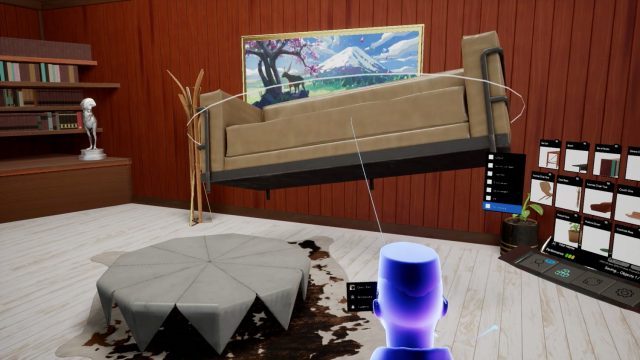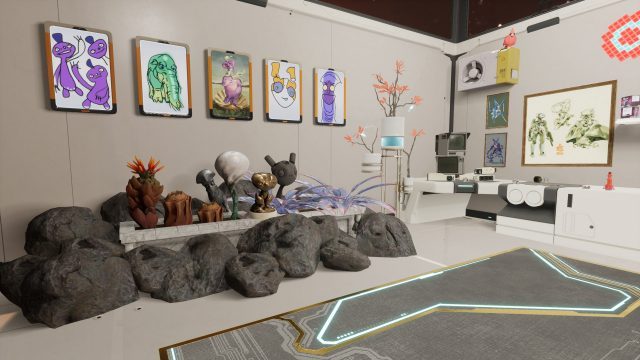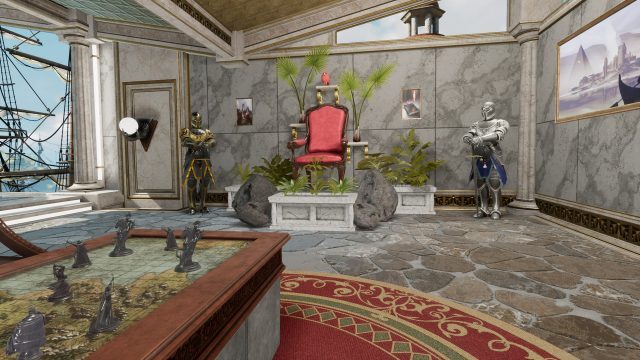Announced back in October, Oculus is launching the Rift Core 2.0 update today in beta, a major overhaul to the platform’s underlying experience. The update not only rebuilds the default ‘Home’ environment with huge customization potential, it also introduces ‘Dash’, a new take on the former Universal Menu, which also allows you to use desktop PC applications from within any VR app.
The Rift Core 2.0 update is now available in beta. You can download it and give it a go for yourself by opting in to the Public Test Channel through the Oculus desktop application (see instructions here), it may take some time to roll out to everyone.
Oculus Home
‘Home’ is the place where you go when you put on your Rift but you haven’t yet launched a VR app. Previously it was a static environment (save for a certain wrinkled carpet) that served as a simple Store and Library browser for Oculus content. In the Rift Core 2.0 update, those browsing functions have been moved to Dash (more on that below), which frees up Home to become your personal(izeable) virtual space.
With the beta launch, everyone’s Home will have the same floorplan, a rectangular room that’s closed on one side (with a fireplace in the corner) and open-air on the other. However, you can change the look and feel of the room via a menu, including the outside environment, which allows you to drastically change the mood with just a few clicks.
Once you pick out the basic look and feel you can start digging through a gallery of virtual items with which you can populate the environment. These items range from pieces of furniture to rocks, plants, decorations, and more. Between the items available and cobbling together entirely new items by using what’s available as building blocks, quite a bit of time could be spent getting your space just right. While many of the items are static, many objects abide by physics and some—like the light gun and the bow—are properly interactive, allowing you to pick them up and fire projectiles.
You’ll start with a default set of objects, many of which may look familiar if you’ve played Oculus first-party titles like Toy Box & Farlands, but you can also unlock new objects by playing certain games. Once you unlock some new stuff for your Home, you’ll be able to redeem it via a menu which pops up a little loot box in front of you, which you smash on the ground, and out pop your new items. For now, Oculus controls when and how you unlock new items, but the company says they’re thinking about how third-party developers could have their games interoperate with Home.
Hardly Social For Now
One aspect of Home that Oculus touted during its announcement was that it will eventually be a persistent and social environment where you could hang out and have fun with friends. While that plan is still on the roadmap, in the initial beta launch there’s no ability for two friends to be in the same Home space together. The most ‘social’ thing you can do is visit a friend’s space solo to see how they’ve decorated it, but even the ‘persistence’ that Oculus had talked about isn’t here yet, meaning there’s no way for you to leave any trace that you’ve been there.
Oculus says that over time the plan is to layer in social features like persistence and true multiplayer, and that—over the next year or so—people can expect to see more metaverse-like interactions coming to Home.
Dash
‘Dash’ is the replacement for the old Universal Menu—that menu you could pull up in the middle of any VR game to look at your friends list and make a few other adjustments to your experience. While the old Universal Menu has changed little from launch, and was built for navigation with a gamepad, Dash is fundamentally designed for the Touch motion controllers (though Oculus says using a gamepad will still mostly work).
The new Dash can be called up during any VR game, including the entire Library and Store menus, and now floats in front of you while you’re inside the game rather than taking you into a separate space. That makes interacting with Dash a lot more fluid, and means you don’t have to completely leave your current game to browse the store or launch a new one.
Oculus Desktop
With Dash, Oculus is also making their first steps toward making VR into a computing platform. Oculus Desktop, which is part of Dash, allows you to pull up your PC desktop inside of any VR application and interact with it as you’d expect, keyboard and all. Interestingly, the floating keyboard that you’ll see pop up for entering text is Windows’ own On Screen Keyboard, which means you’re getting system-level text input which also benefits from predictive typing.
Oculus is taking things one step further than other virtual desktop applications by allowing you to grab windows and pull them out of your desktop and into their own separate window in your virtual space. That means you can easily configure your virtual computing space as you see fit. For instance, you might put Discord to your left, Spotify in the middle, and Messenger on the right, giving you quick access to social channels and music without taking off your headset.
Interestingly, while the Windows Mixed Reality platform offers similar functionality of being able to bring flat desktop apps into your virtual environment, it only works with apps built on Microsoft’s UWP platform (though you can pull up a full desktop view to see non-UWP apps sitting on your desktop). On the other hand, Oculus’ virtual windowing tech works with any app on your desktop, UWP or not.
The hope is that Dash and Oculus Desktop will make being in VR more seamless by making it easier to multi-task and not cutting you off so drastically from the usual functions of your computer.
While Oculus Desktop is the start of VR as a computing platform for the company, even Oculus admits that the resolution of the Rift isn’t high enough for most users to warrant using VR for full-time productivity computing. In fact, for the initial beta release, you won’t be able to use your desktop mouse (though your keyboard should work fine). Oculus says they’re still working on the mouse implementation for those that want to use Oculus Desktop like a traditional desktop computer, but for now a workaround is to enable ‘Pointer Trails’ which will let you see where the mouse is. However, the company says that the way they’ve built the underlying architecture—which involved some collaboration with AMD and NVIDIA—allows Oculus Desktop to scale very well with increasing headset resolution. The implication by Oculus is that they’re making a deep investment in this tech so that it will evolve alongside improvements in hardware.







